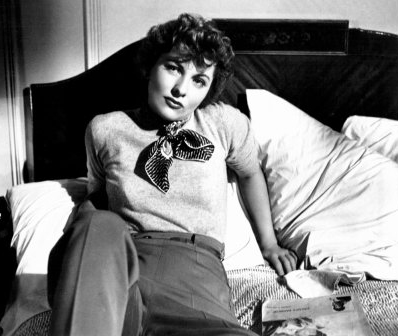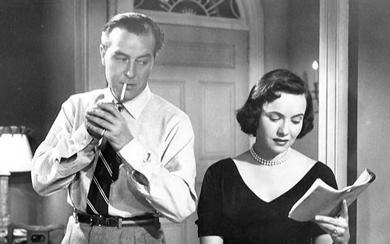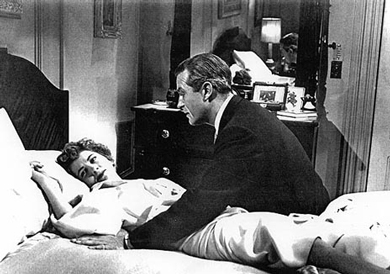
 |
|
|
|
The standard line on producer-director George Stevens is that he was profoundly changed by his experience in WW2. Stevens stopped making his wonderful comedies and applied himself to ever-more sober dramas that searched for meaning in an imperfect world. Long gone was the sheer fun of Swing Time and The More the Merrier; in came the grim social criticism of A Place in the Sun and the liberal moralizing of Giant. That view is something of a generalization, as Stevens' earlier work had turned more than once to grim sentiment (Penny Serenade), and many of his lighter movies were based on real social problems. But with the down-on-America A Place in the Sun Stevens did turn self-important, and foregrounded his artistry as he never had before. Before he moved on to a series of ever more pretentious social epics, Stevens made one more modest picture that seems to have been all but completely forgotten. Usually the first to laud anything from Stevens, critic Bosley Crowther gave 1952's Something to Live For a real razzing, reserving most of his disdain for the screenplay by Dwight Taylor. Something rarely arises in discussions of Stevens' work. Andrew Sarris' filmography for the director in The American Cinema leaves it out entirely! 
Okay, so Something to Live For is not a George Stevens masterpiece. But there's a good case to be made for seeing lesser films by great directors, if one really wants to understand how film artists function. Something to Live For has been fairly accurately described as a follow-up to Billy Wilder's The Lost Weekend. It plays out in a similar New York City, a non-magic place that rewards ambition and achievement but also breeds disenchantment and alienation. Aging, insecure ad man Alan Miller (Ray Milland) is a recovered alcoholic and AA volunteer. He responds to a call from Billy the Elevator Operator (Harry Bellaver) and is surprised to find that his contact is a woman. Rising actress Jenny Carey (Joan Fontaine) is on a serious drunk. Her mentor Tony Collins (Richard Derr) has responded to her calling off their affair with a barrage of snarky criticism that has shaken Jenny's self-confidence. She's been replaced in a good part for not showing up for rehearsals. Jenny and Alan strike up a friendship that threatens to become a romance. But Alan is in his own way dishonest. He eventually reveals that he is married to the loving and considerate Edna (Teresa Wright) and has two young boys. Yet Alan seems to need Jenny's support as much as she needs his. He's having a difficult time staying motivated at work, with young ad writer Baker (Douglas Dick) bucking for his job. How will Jenny and Alan resolve their feelings without destroying Alan's marriage? Screenwriter Dwight Taylor based the Fontaine character on his mother Laurette, a famous actress who wrestled with a drinking problem. Something to Live For is said to be one of the first movies to work the organization Alcoholics Anonymous into its plotline. Although George Stevens' purpose seems to be to give a realistic picture of the pressures faced by alcoholics in America, his film is curiously unfocused. True, it is good that the screenplay does not blame drinking problems on pat traumas like lost children or oppressive parents, as did a number of post- Lost Weekend shows. Despite the frequency of substance abuse in their respective careers, we find it difficult to identify with Alan and Jenny's predicament. This is probably because we expect movie stars of this era to play people more "together" than this, or if not, to have more pronounced flaws. Jenny doesn't have what it takes to brush off her insecurities. She comes off as too weak to be a successful actress. Alan doesn't tell Jenny that he's married until they've already made a connection, and she happens to ask. That makes him a puzzle not unlike Dick Powell's character in the frightening noir Pitfall. Alan has a perfect family and makes a good living, but is disenchanted for reasons he can't define. The surface reason is probably low self-esteem - he's as fed up with the pointlessness of his career as he is with his weakness for drink. Alan's colleagues call advertising a racket and play it like a blood sport, angling for the big accounts and the big salaries. This section of the movie comes off as a simplistic pre-echo of Mad Men. Alan is thoroughly disgusted when the eager beaver junior writer Baker scores a big account with an offensive ad campaign that suggests that a husband and wife can indulge romantic fantasies on board a luxury cruise ship. An advertising business party is exceedingly unpleasant. While the big boss frets that Alan might be falling off the wagon, younger punks and cynics spread gossip that he's an ex-lush and an all-round loser. Jenny attends the same party and is confronted by her ex-boyfriend Collins, who turns out to be an insincere and insinuating jerk. The film' Although the movie says it's about alcoholism and personal responsibility, its title suggests a broader meaning. Something to Live For shows characters in search of dependable values in a society that no longer seems to respect people -- in 1952! Alan and Jenny's confidence in their personal life goals has been shaken. Jenny is too fearful to keep up the theatrical struggle, and Alan has difficulty appreciating his wonderful family. George Stevens does some things very well. Alan finds that alcohol pushed is in his face no matter where he goes - at work, in restaurants, at parties. Turning down a drink is considered impolite, and even grounds for resentment. Headwaiters keep telling Alan to "wait at the bar." 
Other effects must be chalked up in the Nice Try column. The script attempts to generate emotional suspense by having Alan and Jenny continually miss each other's phone calls, just by a second or two. Before the age of effortless communication this was not uncommon, but when the two maybe-lovers lose their nerve because nobody answers, they come off as weaklings. Stevens arranges several scenes with Alan and Jenny to frustrate romantic clichés, perhaps in response to David Lean's Brief Encounter. The delivery of a cute potted plant just misses its intended recipient. A desperate late night meeting in a train terminal leads nowhere. Something to Live For fights an uphill battle against convention. It looks like a Hollywood movie but refuses to let anything really transgressive occur between its unhappy 'acquaintances'. Contemporary reviewers simply saw it as a movie where 'nothing happens.' Stevens overuses the slow dissolve experiments that were so effective in his A Place in the Sun. Alan stares out a window and a six- or ten- second dissolve slowly merges his face with a shot of traffic in the street below. The visual very nicely communicates Alan's weary alienation, but since the film has little narrative momentum it evokes the same disaffection in the audience. 1 On other levels Something to Live For misses the boat entirely. The Broadway episodes are not very interesting, and not because Jenny's big play is an unimpressive show called "The Egyptians". We're not given any evidence to suggest that Jenny is a rising star. She consistently wins parts, but doesn't seem to have a close friend in the business, not a fellow actress or a stage manager or anybody. Alan's effort to sober up Jenny for her "big debut" floats an unimpressive dramatic finale. Stevens arranges for the movie to be bracketed by the raising and lowering of a stage curtain, but with the camera facing away from the stage. This motif suggests that the real drama is to be found out in the audience, but I doubt that many viewers picked up on the idea. Finally, Alan's home life with Teresa Wright is just not interesting. Wright's Edna connects the dots early on that something is wrong with hubby (a blind ox could figure that out, the way he mopes around) but adheres to the Production Code's Honorable Wife Rule Book. Edna never confronts Alan but instead offers support and gently asks what's wrong. She remains a tower of sterling values and quiet courage. Frankly, it seems that she could catch Alan in a six-way orgy, and Edna would still "understand" him. The only time she shows anxiety is when she thinks he's been drinking ... if he comes home sober, she figures everything's okay. The film's "realistic" view of marriage is as uncomplicated as that of It's a Wonderful Life. 2 Perhaps Something to Live For is simply ahead of its time, a more modern story trapped in the conventions of 1952 Hollywood. Ray Milland and Joan Fontaine are always subdued; nobody in the show loses their head or even blows off steam. A mark against the show is the fact that even when Edna is supposed to be on the soggy end of a bender, Joan Fontaine never looks worse for wear, just a little disoriented or unfocused. I'm not well versed with the full range of alcoholic states but to me she comes off as consistently glamorous. We love Teresa Wright and therefore wish her Edna could vent her frustration by kicking a cat, or asking why SHE can't express her existential alienation. No, having two kids in a 1952 movie apparently guarantees a woman personal stability and fulfillment. One year later George Stevens would present a more compelling picture of matrimonial uncertainty in his overblown, but effective, Shane. 
Douglas Dick is good as the SOB ad man Baker and Richard Derr passable as the cultured reptile Tony Collins. Paul Valentine of Out of the Past has a couple of nice moments as Jenny's co-star Albert, the slave to her Pharaoh-ette. Albert seems a good sort; she and he should get together if he's not gay. Glimpsed quickly in the show are the interesting starlets Mari Blanchard (She Devil) and Kasey Rogers (Strangers on a Train). Where Something to Live For really lets us down is by not rewarding Bill the Elevator Operator, played by the talented Harry Bellaver. Billy's the real Mensch in the movie. He's forever doing favors for people and takes care of Jenny as if she were his own daughter. We want the big-hearted Billy to take care of us, too! With people like him in the world nobody has an excuse to be a cynic. Both Alan and Jenny should buy that man a dinner, take him to a show, and bring him home for Christmas. Olive Films' DVD of Something to Live For is an excellent transfer and encoding of this George Stevens rarity. The picture and soundtrack are both carefully rendered, giving the completist film fan what's needed to assess the show on dramatic and technical standpoints.
On a scale of Excellent, Good, Fair, and Poor,
Something to Live For rates:
Footnotes: 1. Stevens' technical experimentation extends to his soundtrack as well. To make dialogue scenes more realistic, he leaves some volume levels low when people aren't close to the camera. At more than one point in the story, Alan and Jenny talk in medium-long shot. Their voices are unusually quiet, as if we were eavesdropping from thirty feet away. Does the idea work? I don't know ... I missed some dialogue, and thought instead that a lot of effort was being expended on a theoretical idea.
Oh, by the way. The film's nighttime shots of Times Square were taken in 1950 -- John Ford's Wagon Master is playing across the street from Destination Moon. The marquee for the space film stretches upward across four or five stories of a corner theater!
2. Now, if George Bailey had actually been unfaithful to Donna Reed, Capra's movie would be much more complicated, sad, and human. Remember how George was victimized by gossip about him and Violet Bick? Curiously, Alan Miller is very pointedly seen to get an alcoholic drink spilled on him at a party. We fully expect the odor to become an issue when he returns home ... and nothing comes of it. Something to Live For has a number of loose ends like that one. 3. A welcome note from John McElwee, whose Greenbriar Picture Shows page is not to be missed: Savant Scores! Hey Glenn --- Enjoyed very much your coverage of the rarest of rare G. Stevens pics, Something To Live For, for which I could find no evidence of a U.S. network or syndicated TV run (do you recall it ever being on?), making this an even more elusive Paramount than My Son John! Finally watched last night after nearly a lifetime's wait. Wonder if some ownership of Live For reverted to Stevens, causing it to disappear for so many years. Maybe Sarris didn't list this one because he couldn't see it! I certainly wasn't able to --- and never once did I come across a 16mm print. That Broadway night glimpse made my heart skip beats. Turns out it was shot during the week of June 21-28, 1950. Based on marquees we see, Bright Leaf was at the Strand, with Tommy Dorsey and Orchestra on stage, Wagon Master at the Globe, and Destination Moon wowing the Mayfair. And that Moon display! Why was I born so late? --- J.
Reviews on the Savant main site have additional credits information and are often updated and annotated with reader input and graphics. Also, don't forget the 2011 Savant Wish List. T'was Ever Thus.
Review Staff | About DVD Talk | Newsletter Subscribe | Join DVD Talk Forum |
| ||||||||||||||||||